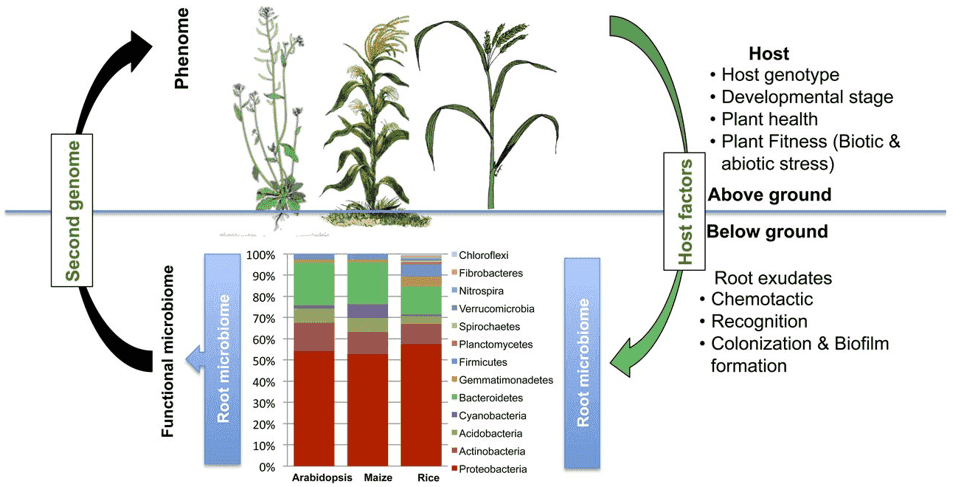Soil microbial species, including the cycling of carbon (C) and other nutrients and the conservation of plant growth, carry essential ecological functions that are critical for life on our planet. Unfortunately, due to the evolving environment and precipitation patterns, soil depletion, and inadequate land management practices, many beneficial functions of soil microbiome are presently threatened. Growing demand has recently been seen in modifying soil microbiomes to preserve the role of the environment.
 Figure 1. Rhizospheric microbiome composition based on a high-throughput analysis. (Lakshmanan 2014)
Figure 1. Rhizospheric microbiome composition based on a high-throughput analysis. (Lakshmanan 2014)
With a better understanding of how soil microbiomes work under various environments, the ability to control ecosystem resources and to bioprospecting soil microbial metabolism would be feasible. However, the discovery and management of soil microbiomes remain a challenging challenge since most soil microbes have not yet been isolated and molecular specifics are mostly cryptic underlying their functions.
Sampling Method
When gathering samples, avoid small locations, such as wet patches, manure and urine areas, locations where wood dumps have been burned, heavily deteriorated fields, old construction sites, fencerows, spoil banks, and burn-row areas, where the soil conditions are clearly different than those in the rest of the field. In fields where row crops have been planted, avoid the fertilizer bands. Since samples obtained from these positions in the remainder of the field would not be representative of the soil, they could also give inaccurate findings. Areas throughout a field where multiple crops have been grown in the past should be sampled individually, even though you are now trying to grow the same crop in the field. It is therefore important to separately sample areas that have been limed and fertilized differently from the rest of the region.
Prevent contaminating the samples with traces of chemical elements (micronutrients) from the sampling instruments by retrieving the samples with stainless steel or chrome-plating sampling tools and plastic buckets. Also prevent using tools made of brass, copper, or galvanized.
For DNA extraction which is used for sequencing, fill a clean, labeled 2 mL tube with approximately 3 g of soil from collected field samples using a sterile metal spatula. Remove small root fragments and debris of some sort. Keep this sample of soil at -20 ° C. Wash the metal spatula between each sample at 70% ethyl alcohol.
Pre-Treatment Sample Sequence
Before sequencing, soil pretreatment involves grinding, separating the bulk sample to achieve the right sample size and sieving. In the type of aggregates, organic and inorganic constituents are typically present and this accumulation helps to contribute substantially to variability within the portion. In order to correctly classify the geological sample resource, the whole sample must then be processed and sub-sampled for analysis. For it, the procedure involves crushing and grinding to particles of uniform scale, meaning that crushers eliminate solid particles and then refining reduces the crushed sample. Once the sample is reduced, the sample is sieved and the fraction with a granulometry of < 2 mm is used for analysis, but a finely grounded soil (< 150 μm or < 0.06 mm) is suggested if more thorough treatment of the sampling of inhomogeneous geochemical materials is needed. The next stage is quartering, which is the method of minimizing a representative soil or sediment sample to a decent size. When subsamples occur, a homogenization step is often needed to ensure that all subsamples have the same structure and properties. The purpose of the pre-treatment is to enhance the analytes in the sample with respect to water and biological content.
References
- Jansson JK, Hofmockel KS. The soil microbiome—from metagenomics to metaphenomics. Current opinion in microbiology. 2018, 43:162-8.
- Lakshmanan V, Selvaraj G, Bais HP. Functional soil microbiome: belowground solutions to an aboveground problem. Plant physiology. 2014, 166(2):689-700.


 Figure 1. Rhizospheric microbiome composition based on a high-throughput analysis. (Lakshmanan 2014)
Figure 1. Rhizospheric microbiome composition based on a high-throughput analysis. (Lakshmanan 2014)